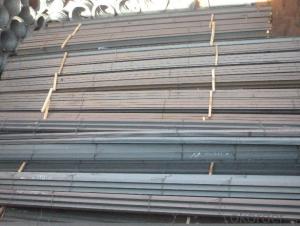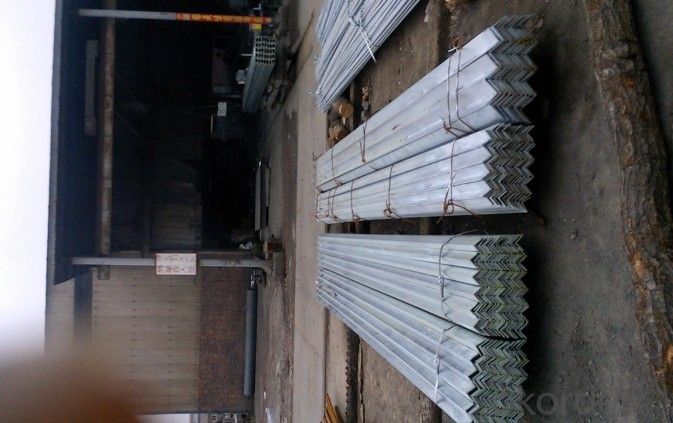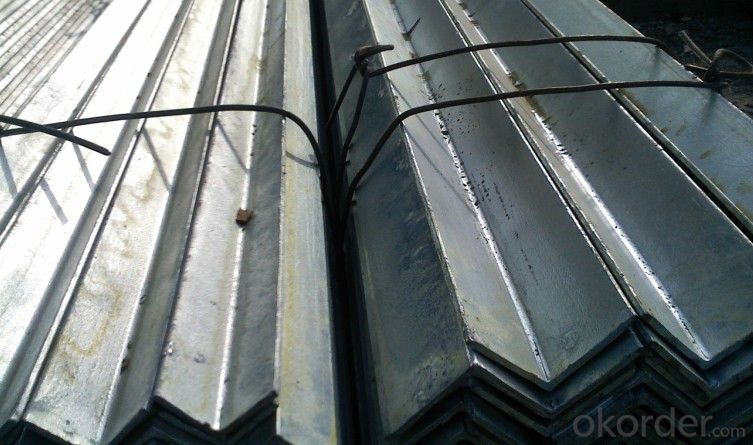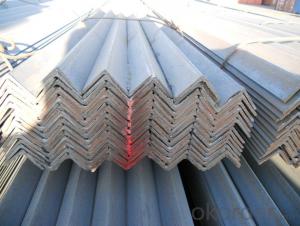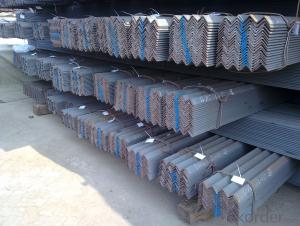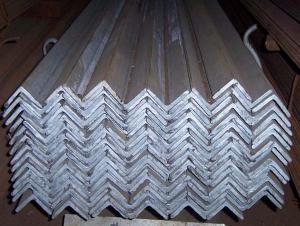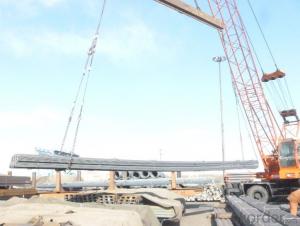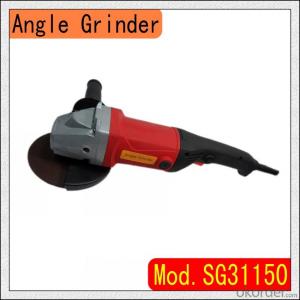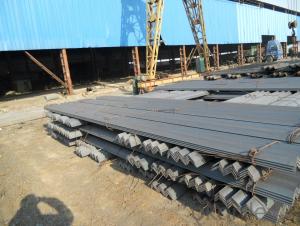angle
- Loading Port:
- China Main Port
- Payment Terms:
- TT OR LC
- Min Order Qty:
- -
- Supply Capability:
- -
OKorder Service Pledge
OKorder Financial Service
You Might Also Like
Product Description:
Specifications of Angle Steel
1. Invoicing on theoretical weight or actual weight as customer request
2. Length: 6m, 9m, 12m as following table
3. Sizes

Sizes: 25mm-250mm | ||
a*t | ||
25*2.5-4.0 | 70*6.0-9.0 | 130*9.0-15 |
30*2.5-6.6 | 75*6.0-9.0 | 140*10-14 |
36*3.0-5.0 | 80*5.0-10 | 150*10-20 |
38*2.3-6.0 | 90*7.0-10 | 160*10-16 |
40*3.0-5.0 | 100*6.0-12 | 175*12-15 |
45*4.0-6.0 | 110*8.0-10 | 180*12-18 |
50*4.0-6.0 | 120*6.0-15 | 200*14-25 |
60*4.0-8.0 | 125*8.0-14 | 250*25 |
5. Payment terms:
1).100% irrevocable L/C at sight.
2).30% T/T prepaid and the balance against the copy of B/L.
3).30% T/T prepaid and the balance against L/C
6.Material details:
Alloy No | Grade | Element (%) | |||||
C | Mn | S | P | Si | |||
|
|
|
|
|
|
| |
Q235 | B | 0.12—0.20 | 0.3—0.7 | ≤0.045 | ≤0.045 | ≤0.3 | |
|
|
|
|
|
|
| |
Alloy No | Grade | Yielding strength point( Mpa) | |||||
Thickness (mm) | |||||||
≤16 | >16--40 | >40--60 | >60--100 | ||||
≥ | |||||||
|
|
|
|
|
| ||
Q235 | B | 235 | 225 | 215 | 205 | ||
Alloy No | Grade | Tensile strength (Mpa) | Elongation after fracture (%) | ||||
Thickness (mm) | |||||||
| ≤16 | >16--40 | >40--60 | >60--100 | |||
≥ | |||||||
|
|
|
|
|
|
| |
Q235 | B | 375--500 | 26 | 25 | 24 | 23 | |
Usage & Applications of Angle Steel
According to the needs of different structures, Angle can compose to different force support component, and also can be the connections between components. It is widely used in various building structures and engineering structures such as roof beams, bridges, transmission towers, hoisting machinery and transport machinery, ships, industrial furnaces, reaction tower, container frame and warehouse etc.
Packaging & Delivery of Angle Steel
1. Packing: it is nude packed in bundles by steel wire rod
2. Bundle weight: not more than 3.5MT for bulk vessel; less than 3 MT for container load
3. Marks:
Color marking: There will be color marking on both end of the bundle for the cargo delivered by bulk vessel. That makes it easily to distinguish at the destination port.
Tag mark: there will be tag mark tied up on the bundles. The information usually including supplier logo and name, product name, made in China, shipping marks and other information request by the customer.
If loading by container the marking is not needed, but we will prepare it as customer request.
Production flow of Angle Steel
Material prepare (billet) —heat up—rough rolling—precision rolling—cooling—packing—storage and transportation
- Q: Can steel angles be used in outdoor or exposed environments?
- Steel angles can indeed be utilized in outdoor or exposed settings. Typically, they are crafted from galvanized steel, which receives a layer of zinc as a protective coating to ward off rust. Consequently, their resistance to corrosion is heightened, rendering them suitable for outdoor purposes. Furthermore, steel angles are renowned for their robustness and longevity, rendering them a dependable option for diverse outdoor structures like fences, railings, and supports. Nevertheless, it is essential to bear in mind that regular upkeep and assessment may be necessary to uphold the ongoing integrity and functionality of steel angles in outdoor or exposed environments.
- Q: What are the different types of connections used for steel angles in industrial settings?
- In industrial settings, there are several types of connections used for steel angles depending on the specific application and structural requirements. Some of the commonly used connection types include: 1. Welded Connections: Welding is a popular method for connecting steel angles in industrial settings. It involves joining the angles using heat and pressure, resulting in a strong and durable connection. Welded connections are typically used when high strength and rigidity are required. 2. Bolting Connections: Bolts and nuts are used to connect steel angles in bolting connections. This type of connection allows for ease of assembly and disassembly, making it suitable for applications where flexibility and adjustability are important. Bolting connections can be easily tightened or loosened as needed. 3. Riveted Connections: Riveting involves using metal rivets to connect steel angles. This connection type offers good strength and stability and is commonly used in heavy-duty applications. Riveted connections require specialized equipment and skilled labor for installation and removal. 4. Adhesive Connections: Adhesives can also be used to bond steel angles together. This type of connection provides good load distribution and can be used in applications where welding or bolting is not feasible. Adhesive connections require proper surface preparation and adhesive selection to ensure adequate bonding strength. 5. Mechanical Connections: Mechanical connections such as cleats, brackets, plates, or clips can be used to connect steel angles. These connections provide flexibility and ease of installation, allowing for adjustments and modifications in the future if needed. It is important to note that the selection of the connection type depends on various factors such as the load-bearing capacity required, the structural design, safety considerations, and the specific environmental conditions in the industrial setting. Consulting with structural engineers and following industry standards and codes is crucial to ensure the appropriate type of connection is used for steel angles in industrial applications.
- Q: How do steel angles compare to aluminum angles in terms of strength and durability?
- Steel angles are generally stronger and more durable than aluminum angles. Steel has a higher tensile strength and yield strength, meaning it can withstand greater forces and pressures without deforming or breaking. Additionally, steel is more resistant to corrosion and can maintain its structural integrity for longer periods compared to aluminum, which is more prone to oxidation and may weaken over time. Therefore, for applications requiring high strength and long-term durability, steel angles are a preferable choice over aluminum angles.
- Q: Can steel angles be used for framing?
- Framing in construction projects can indeed utilize steel angles. These L-shaped metal profiles, also known as angle irons, possess remarkable strength and durability. Their structural stability and capacity to bear heavy loads make them widely employed for framing purposes. Steel angles can be easily manipulated through cutting, welding, and bolting to generate robust frames for diverse structures like buildings, bridges, and industrial facilities. They commonly serve as vertical or horizontal supports, bracing elements, or lintels to ensure stability and structural integrity. Moreover, steel angles can be galvanized or coated to enhance their resistance to corrosion, rendering them suitable for both indoor and outdoor framing applications. In conclusion, steel angles represent a versatile and dependable option for framing in construction projects.
- Q: Can steel angles be used in electrical or telecommunications installations?
- Yes, steel angles can be used in electrical or telecommunications installations. Steel angles are commonly used as structural supports and mounting brackets in these types of installations due to their strength, durability, and versatility.
- Q: What are the different surface treatments available for steel angles?
- There are several surface treatments available for steel angles, including galvanization, painting, powder coating, and epoxy coating.
- Q: Are steel angles resistant to wind loads?
- Yes, steel angles are generally resistant to wind loads due to their high strength and structural integrity.
- Q: Can steel angles be used for electrical conduits?
- No, steel angles cannot be used for electrical conduits as they are not designed or suitable for carrying electrical wiring. Electrical conduits are typically made of materials such as PVC, steel, or aluminum that are specifically designed to safely enclose and protect electrical wires.
- Q: Are steel angles suitable for supporting countertops?
- Yes, steel angles are suitable for supporting countertops. Steel angles are strong, durable, and can provide excellent support for countertops, making them a popular choice in many construction and kitchen design projects.
- Q: What is the typical thickness of the legs of a steel angle?
- The typical thickness of the legs of a steel angle can vary depending on the specific application and structural requirements. However, in general, the thickness of steel angle legs can range from 1/8 inch to 3/4 inch.
Send your message to us
angle
- Loading Port:
- China Main Port
- Payment Terms:
- TT OR LC
- Min Order Qty:
- -
- Supply Capability:
- -
OKorder Service Pledge
OKorder Financial Service
Similar products
Hot products
Hot Searches
Related keywords
